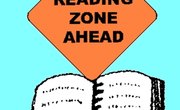Improving Prosody During Reading
Prosody refers to the amount of expression used when reading aloud. Prosody consists of the intonation of the voice when the text is being read, the timing the reader gives each sentence, the stress placed on different words and syllables within words and the focus with which the reader reads. Literacy teachers should pay close attention to prosody in young readers because children who have difficulty with prosodic reading may also be having difficulty comprehending what they are reading. There are activities that can be used to improve prosody during reading. Syntactic skills can also be learned in this method. This method can be used to help decode learning errors, as well as decrease stress patterns in learning.
The practice of prosody can be found from the findings of Wisenbaker, Samuels, Stahl, Schwanenflugel, Rasinski and Kuhn in the Journal of Educational Psychology findings. Reading research quarterlies also mention prosody in their learning findings.
Use reader's theater to practice and build fluency. Because there are no costumes or props, the performance relies solely on the reader's ability to convey the meaning of the words to the audience. Prosody improves as children repeatedly rehearse their lines, increasing accuracy and automatic word recognition. This method also allows for reading fluency, reading comprehension, reading skills, English ability, oral reading skills, word reading skills, expressive reading, oral language and oral language fluency, phonics, phonetics, reading ability, reading instruction, sentence structure, and silent reading abilities to be improved over time and use.
Model prosodic reading for young readers by reading aloud to the children while making sure to demonstrate the proper inflections and expressions in your voice. Model how the text should be read so the children can hear what it sounds like. Model prosodic reading for young readers by reading aloud to the children while making sure to demonstrate the proper inflections and expressions in your voice. Model how the text should be read so the children can hear what it sounds like.
This style of teaching reading with prosody allows students to work alone, or in small groups, to be influenced by prosodic features and practice reading in a new way for improved oral reading fluency and language arts skills. Fluent reading can be achieved by using oral reading prosody as well as other good prosody skills and lessons for English language learning in elementary schools and middle schools. A fluent reader can also improve reading rates and automaticity with prosody. Rereading during prosody practices can also help in the learning process.
Have children listen to popular children's books on tape, which is another form of modeling prosody. After they listen to the story, ask the children to record themselves reading the story. Having them listen to their own voices will allow them to hear places in their reading where their intonation, timing or stress may be incorrect. Allow them to record the story again to correct their mistakes.
Related Articles
References
Resources
Writer Bio
Kimberley McGee is an award-winning journalist with 20+ years of experience writing about education, jobs, business trends and more for The New York Times, Las Vegas Review-Journal, Today’s Parent and other publications. She graduated with a B.A. in Journalism from UNLV. Her full bio and clips can be seen at www.vegaswriter.com.










